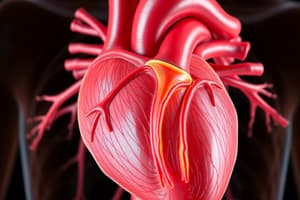Podcast
Questions and Answers
What is the primary function of desmosomes and gap junctions in cardiac muscle?
What is the primary function of desmosomes and gap junctions in cardiac muscle?
- To physically coordinate the contraction of individual cardiac myocytes (correct)
- To generate the cardiac action potential
- To modulate calcium-induced calcium release in cardiac muscle
- To support the flow of depolarization through the conducting pathway
Which cellular structures in myocytes support contraction by causing a sarcomere to shorten?
Which cellular structures in myocytes support contraction by causing a sarcomere to shorten?
- Gap junctions
- Ion currents
- Desmosomes
- The contractile apparatus (correct)
Why is modulation of calcium-induced calcium release important for contractility in cardiac muscle?
Why is modulation of calcium-induced calcium release important for contractility in cardiac muscle?
- To coordinate heart function through the electrically synchronized activity of myocytes
- To regulate the flow of depolarization through the conducting pathway
- To adjust the force of muscle contraction based on the amount of calcium available (correct)
- To generate an action potential in pacemaker cells
Which ion currents are primarily responsible for the cardiac action potential?
Which ion currents are primarily responsible for the cardiac action potential?
Why do cardiac cells not undergo tetany unlike skeletal muscle cells?
Why do cardiac cells not undergo tetany unlike skeletal muscle cells?
What is the primary function of the Purkinje fibers in the heart?
What is the primary function of the Purkinje fibers in the heart?
Flashcards are hidden until you start studying



